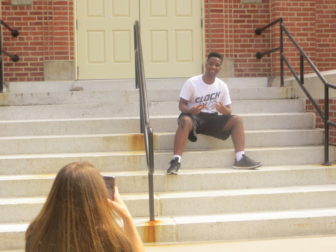Traditionally, schools are in session nine months, but an increasing number of districts nationally have turned to year-round calendars to improve academics and better serve struggling students.

Christian Thomas gets his photo taken by Natalie Wright.
Year-round schools have increased by about 26 percent since 2007, according to Niche.com. There are 3,181 year-round schools in the United States, according to the website. In the United States, 46 out of 50 states have at least one year-round school.
Esther Fusco, a professor at Hofstra University’s School of Education, Health and Human Services, told the Associated Press in 2012 that overall, “research suggests that students in high-needs districts and those who have disabilities do better in year-round learning situations. This is logical because these students do not have the downtime that occurs over the summer. But the results are not very significant. I have not seen any study that shows students greatly improve.”
There have been mixed feelings among parents and teachers about whether a year-round schedule is effective. According to the Salt Lake Tribune, 86 percent of teachers in that city were in favor of the year-round model, and only 50 percent supported switching back to the traditional schedule. Because of the cost, many of Salt Lake City’s schools now operate on a traditional academic schedule.
Students’ opinions were not included in that study. One Hartford student, Raylend Wilson, who attended Capital Preparatory Magnet School year round for five years, had a generally positive experience.
“I liked it,” he said. “It was a good learning environment and the teachers knew how to teach.”
School activities also were not affected by the year-round schedule, Wilson said.
“I knew how to prioritize my time and how to manage my homework and projects,” he said. The year-round schedule did have some effect on grades, he said.
“I feel like it had an effect because people tend to get lazy and sick of school and by the end of the year, they didn’t really work or try when they were given school work,” he said.
In terms of the calendar, however, Wilson, who now attends University High School of Science and Engineering in Hartford, said he would not make any changes. There were positives and negatives to going to school year round, Wilson said.
“A positive is that with the year-round schedule, you have more chances to get a good grade,” he said. “The negative is that it’s too long.”
If there is one piece of advice that Wilson would give, it would be to pay more attention in class.
“Pay more attention and stay more focused at the end of the school year,” Wilson said.
Christian Thomas is a student at University High School of Science and Engineering.
An interesting article. Nicely done.